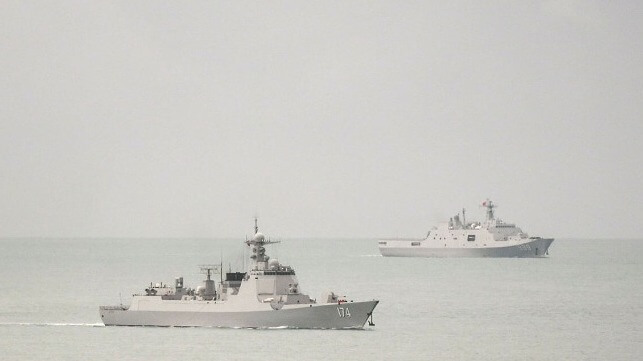"Danger Zone": Why China May Pose a Greater Threat as its Power Peaks

The prevailing consensus for the past few years has been that an ascendant China is threatening to overtake a slumping America. ‘If we don’t get moving, they [China] are going to eat our lunch,’ US President Joe Biden told a group of senators in 2021.
Research suggests that a geopolitical power transition is most likely to take place when a surging challenger overtakes an exhausted hegemon. In assessing the threat posed by China, it has become popular to refer to the Thucydides’ trap, named after the Greek historian and general who blamed the Peloponnesian War on the threat posed by a rising Athens to an established Sparta. The message is clear: a turbo-charged China has increased the likelihood of conflict with America.
In "Danger Zone: The Coming Conflict with China," Hal Brands and Michael Beckley challenge this notion and offer a more nuanced view. Brands is a professor at the Johns Hopkins University School of Advanced International Studies, and Beckley is an associate professor at Tufts University. In their cogently argued book, they provide a fresh take on the likelihood of Sino-American war.
As Brands and Beckley see it, China is simultaneously both a rising and a declining power. While China continues to rise in terms of military might, measured in economic and demographic terms it is already firmly on a downward trajectory. No less significant, President Xi Jinping’s assertiveness has alerted the world to China’s ambitions, and the world is gearing up to respond. Consequently, China has a rapidly closing window of time in which to realize its plans.
The authors call this the ‘peaking power trap’. Conventional thinking suggests that China will bide its time until its military is strong enough to guarantee success, but the authors suggest that the pressure is on, and a conflict could be imminent.
Brands and Beckley remind us that China’s economic performance peaked more than a decade ago. With the effects of the government’s COVID-19 policies cramping productivity and real-estate markets tanking, the economy grew by a historical low of only 3.0 percent in 2022 and is expected to grow by 4.3 percent this year. China’s boom years are a thing of the past.
During his first decade in office, Xi demonstrated only too clearly that he prioritizes ideology over markets. His reappointment in October for another five years means his state-centric economic policies look set to continue. The reforms needed to revitalize China’s economy will likely remain on the backburner. Xi’s new leadership team has little economic experience and received a chilly reception from financial markets.
China’s economic woes are compounded by the demographic legacy of its one-child policy, which has left the country with an aging population, a rapidly diminishing workforce and a soaring pension bill. Last year, China’s population declined for the first time since 1961. Its workforce peaked already, in 2014, and has been declining ever since. By mid-century, the working-age population is expected to decrease by a staggering 200 million, further dimming the country’s economic prospects.
In stark contrast to Deng Xiaoping’s policy of ‘hiding one’s strength and biding one’s time’, Xi’s ‘wolf warrior’ foreign policy has alarmed the world. As a result, China is operating in an increasingly hostile international environment. The United States, Japan and Taiwan are actively stepping up their military capabilities, and Indo-Pacific cooperation has been bolstered through a reinvigorated Quad. European countries are also responding, with the United Kingdom and Germany strengthening their military presence in the region.
Brands and Beckley remind us that anxiety and opportunity make a lethal cocktail. Chinese leaders may be concerned that they need to act soon, before their country slips into full-scale decline. ‘Once-rising powers,’ the authors note, ‘often become most aggressive when their fortunes fade, their enemies multiply, and they realize that they must reach for glory now or miss their opportunity forever.’ Some of the bloodiest wars in history were started not by rising powers but by countries that had peaked and started to decline. These include Germany in 1914, Japan in the late 1930s and, of course, President Vladimir Putin’s Russia in 2022.
With the world’s attention focused on Russia’s war in Ukraine, China may feel that the time for action is at hand. The composition of Xi’s new leadership team highlights this risk. During his first two terms in office, Xi had to share power in the Politburo Standing Committee with the moderate Youth League faction. Now that China’s highest decision-making body is stacked with Xi loyalists, there’s likely to be less room for debate and dissent, even on key strategic decisions.
In March 2021, Admiral Philip Davidson, who at the time was in charge of the US Indo-Pacific Command, controversially claimed that China could trigger a conflict over Taiwan as soon as 2027. Brands and Beckley think it could happen much sooner. That might seem alarmist, but the authors present a strong case.
Robert Wihtol is an adjunct faculty member at the Asian Institute of Management and former Asian Development Bank country director for China and director general for East Asia.
This article appears courtesy of The Strategist and may be found in its original form here.
The opinions expressed herein are the author's and not necessarily those of The Maritime Executive.

